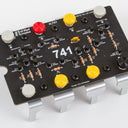The XL741 Discrete Op-Amp Kit
by Evil Mad Scientist




Build a working transistor-scale replica of the classic and ubiquitous analog workhorse.
The "XL741" Discrete Operational Amplifier kit from Evil Mad Scientist Laboratories is a faithful and functional transistor-scale replica of the μA741 op-amp integrated circuit, the classic and ubiquitous analog workhorse.
An Operational Amplifier, or "op-amp" as they are commonly known, is one of the most useful and common types of analog electronic circuit building blocks. The original μA741 was designed by Dave Fullagar and released by Fairchild in 1968. It quickly became the quintessential and most popular op-amp of all time. While newer op-amp designs may outperform the μA741 in just about every possible respect (speed, noise, voltage range, and so on), the 741 remains widely beloved and in active production today — over 45 years later.
The XL741 kit was designed by Eric Schlaepfer, in collaboration with Evil Mad Scientist Laboratories. The kit is lovingly designed to resemble an (overgrown) integrated circuit, based around an extra-thick matte-finish printed circuit board. It comes complete with a beautiful aluminum display stand that gives the circuit board eight legs in the shape of DIP-packaged integrated circuit pins.
Download Datasheet (1.6 MB PDF file).
Building the kit
The XL741 kit is sold as an easy-to-build soldering kit. It includes the circuit board, resistors, transistors and capacitor that make up the electrical circuit as well as printed assembly instructions. The kit also comes complete with the "IC Leg" stand, and 8 color coded thumbscrew terminal posts.
To build the XL741 kit, basic electronic soldering skill and tools are required, but no additional knowledge of electronics is presumed or required. You provide standard soldering tools: a soldering iron + solder and small ("flush") wire clippers, as well as a Phillips head screwdriver
The kit features easy "through-hole" construction ("No surface-mount nothin' nowhere!"), and (assuming that you have prior soldering experience) should take roughly an hour to build.
Using the "XL741" Discrete Op-Amp
The XL741 circuit is a direct implementation of the "equivalent circuit" from the original Fairchild μA741 datasheet, built up using resistors, individual 2N3904 and 2N3906 transistors, and one capacitor. It comes with terminal posts and solder points so that you can actually connect to it and build up classic and functional op-amp circuits. Using those terminal posts and solder points, you can hook up with with bare wires, lugs, alligator clips, and/or solder joints— however you see fit.
And unlike the chip version, you can even hook up probes to monitor what goes on inside the circuit.
Some performance characteristics are different than those of 741 integrated circuits; please refer to the Absolute Maximum Ratings and Electrical Characteristics in the datasheet for additional details.
Additional specifications
Kit size
- The XL741 kit printed circuit board is 5.215 X 3.175 inches (13.25 X 8.06 cm) in area, and (nominally) 0.100" (2.54 mm) thick.
- Including the "Integrated Circuit Legs" stand and terminal posts, the overall size of the assembled kit is nominally 5.215 X 3.9 X 1.70 inches (13.25 X 9.9 X 4.3 cm).
Materials and construction
- The decorative stand is smooth to the touch and made of anodized aluminum.
- The circuit board in the kit is extra thick for rigidity, and made with a matte-black solder mask finish. It comes pre-fitted with eight 8-32 threaded inserts for the terminal posts.
- All materials (including the circuit board and stand) are RoHS complaint (lead free).
- The included terminal post screws are stainless steel thumbscrews with color-coded plastic caps (1 red, 1 black, 6 gray).
Downloads and additional resources
- Additional specifications are given in the kit's datasheet (1.6 MB PDF file).
- Kit assembly instructions (1.5 MB PDF file). Printed instructions are included with the kit.
- The central documentation page for the kit is found here on our documentation wiki.
We no longer stock this product
It's sad to say goodbye but sometimes we have to retire products to make way for new things.
You may still be able to buy this product directly from our friends at Evil Mad Scientist - check out their website!
Shop with confidence – we've been serving the hobbyist electronics, Maker, and retro gaming communities since 2012.
- Satisfaction or refund guarantee
- Worldwide shipping via mail or courier
- 57,000+ customer reviews
- Secure website and payments
